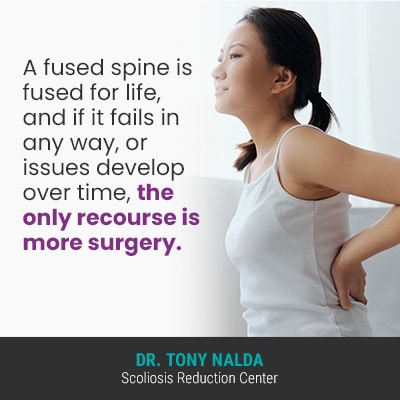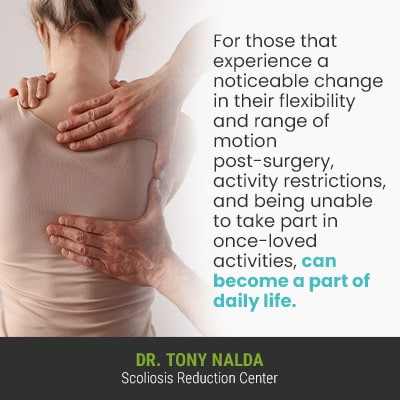When a person receives a scoliosis diagnosis, the most important decision to be made is how to treat it moving forward, and this is because different treatment approaches offer different potential outcomes. The traditional treatment approach tends to funnel patients towards spinal fusion surgery which is a costly, invasive, and lengthy procedure.
There are different ways to treat scoliosis: either surgically or nonsurgically. Many cases of scoliosis can be treated nonsurgically, but for those considering undergoing spinal fusion, the procedure comes with some heavy potential risks and side effects, worthy of consideration.
Before getting to the specifics of spinal fusion surgery, and answering some common questions, let’s first explore what’s happening inside the body of someone recently diagnosed with scoliosis.
Understanding Scoliosis
Being diagnosed with scoliosis means an unnatural sideways spinal curve has developed, and the rotational component makes scoliosis structural, and 3-dimensional condition.
Scoliosis is progressive, meaning it has it in its nature to worsen over time, so a diagnosis means it will be with a person for life; however, it is highly treatable and doesn’t have to define or limit a person.
The spine’s natural curves make it stronger, more flexible, and better able to absorb/distribute mechanical stress incurred during movement.
If a spinal condition, such as scoliosis, causes the spine to lose one or more of its healthy curves, its function, strength, and biomechanics are disrupted, and the condition introduces a lot of uneven forces to the body.
In addition to the spine bending unnaturally to the side, and rotating, a scoliotic curve has to be of a minimum size to be considered a true scoliosis, and this is based on a measurement that’s key to scoliosis surgery: Cobb angle.
A patient’s Cobb angle is taken during X-ray and tells me how far out of alignment the spine is, and classifies conditions on a severity scale:
Mild scoliosis: Cobb angle measurement of between 10 and 25 degrees
Moderate scoliosis: Cobb angle measurement of between 25 and 40 degrees
Severe scoliosis: Cobb angle measurement of 40+ degrees
Very-severe scoliosis: Cobb angle measurement of 80+ degrees
And, remember, as a progressive condition, where a scoliosis is at the time of diagnosis is not indicative of where it will stay; only proactive treatment can counteract the condition’s progressive nature.
So what does a patient’s Cobb angle have to do with scoliosis surgery?
How Does Scoliosis Surgery Work?
For those on the path of traditional scoliosis treatment, once a condition progresses into the severe classification at 40+ degrees, and shows signs of continued progression, this is when patients are commonly funneled towards spinal fusion surgery.
So Cobb angle is also used to craft the traditional treatment approach’s response by helping to determine when a patient becomes a surgical candidate.
While there are different types of spinal fusion surgery, the procedure commonly involves fusing the most-tilted vertebrae, at the curve’s apex, into one solid bone, and the removal of the intervertebral discs that sit between adjacent vertebrae; then metal rods are commonly attached to the spine with screws to hold it in place, and any hardware used is permanent, so to answer the question, is scoliosis surgery permanent: yes, it is.

A fused spine is fused for life, and if it fails in any way, or issues develop over time, the only recourse is more surgery.
So the way scoliosis surgery works is by fusing the most-tilted vertebrae into one solid bone, which eliminates movement in the area so the vertebrae can’t become more tilted, meaning the condition can’t progress; however, there is no guarantee that progression will never occur.
So does scoliosis surgery work? In terms of preventing progression and straightening a crooked spine: yes, it can accomplish these things, but the next question to be asked is how the spine is affected.
What Does Scoliosis Surgery Do?
So we know what the process of spinal fusion involves, but what does it actually do to the spine in terms of its overall health, strength, and function?
Just as no two cases of scoliosis are the same, no two patients will respond to spinal fusion surgery in exactly the same way.
There are a number of key patient/condition variables that factor into how scoliosis surgery will affect a patient: patient age and overall health, location of the vertebrae fused, the number of vertebrae fused, and condition severity.
All surgical procedures come with their share of risks, and spinal fusion is no exception.
When it comes to scoliosis before and after surgery, there are some important potential risks and side effects that patients need to be fully aware of so they can make an informed decision.
While scoliosis surgery, when successful, can stop progression, it can also affect the spine in a number of ways, not to mention risks associated with the procedure itself:
- Nerve damage
- Excessive blood loss
- Infection
- Adverse reaction to hardware used
While not every patient will experience one or any of these potential procedural complications, the risk is there so should be considered, and when it comes to surgery/recovery time, these types of complications are a factor.
Scoliosis Surgery Length
The length of the procedure itself can range from 4 to 9 hours, and any complications will add to that estimate, and of course, there’s not just the length of the surgery to consider, but also patient recovery time.
Recovery time is another fluctuating variable that will vary from patient to patient. Depending on whether or not there were any complications during the procedure, a patient’s overall health and fitness going into the procedure, where their spine was fused, and the number of vertebrae fused all shape a patient’s recovery-experience.
Patients can expect to spend the days immediately following the surgery in the hospital where they can be monitored for signs of infection, or any other potential issues.
During this time, patients are on pain medication, with the goal of being weaned off as soon as possible; most patients are off pain medication within 6 weeks following the surgery, but again, each case is unique with some needing to take medication for longer, and others for shorter periods of time.
When a patient is cleared to return home, this can be within a week, if recovery is going well, and the patient is given certain restrictions such as no driving, lifting, bending/twisting motions until they are cleared for more activity, and this commonly lasts another two weeks.
If recovering well, two weeks after surgery, many patients have restrictions lifted and can return to regular activities and movements within 6 weeks of the surgery, barring any complications, but again, this changes from patient to patient.
What are the Long-Term Effects of Spinal Fusion Surgery?
Just as the short-term effects of the procedure itself will vary from patient to patient, its long-term effects can also vary, and one of the main issues I have with spinal fusion is that there is a large gap in the research/data on long-term effects 30, 40, 50+ years down the road.
For example, what’s the natural longevity of the hardware used? It might fail at some point (rod breaking, cracking, a screw coming loose), and keep in mind, the younger the patient, the longer that hardware has to last inside the body.
Following are some known potential long-term effects of spinal fusion surgery:
- Nerve damage
- Pain at the fusion site
- Hardware failure/malfunction over time
- A spine that’s more vulnerable to injury
- Loss of spinal flexibility and range of motion
As the spine and brain work in tandem to form the central nervous system (CNS), spinal surgery always comes with the risk of nerve damage.
Pain at the fusion site is a disappointing result for many. As the vertebrae are fused together, this is contrary to the spine’s movement-based design, and it’s not just the spine that’s in charge of maintaining its natural curves and alignment, but also its surrounding muscles, which can become sore, stiff, and painful as a result of the fusion.
In addition, stiff and immoveable vertebrae can also become painful, and the removal of intervertebral discs, which help facilitate flexible movement, also impacts the spine’s overall flexibility and range of motion.
We’ve discussed hardware longevity/failure, and while many don’t have issues with hardware used, some do, so the risk is there.
A spine that’s fused is weaker, making it more vulnerable to injury, and the knowledge of living with a weaker spine can have a very-real psychological long-term effect, with some being fearful of trying new things and/or participating in certain activities.
The loss of spinal flexibility and range of motion is the most common complaint I hear from patients post-surgery, and it has the potential to impact quality of life, as all of these potential long-term effects do.
While some patients, particularly those only having two vertebrae fused, find they maintain enough flexibility above and below the fused section, it’s thought that approximately 20 percent of patients will experience this long-term effect.

For those that experience a noticeable change in their flexibility and range of motion post-surgery, activity restrictions, and being unable to take part in once-loved activities, can become a part of daily life.
Conclusion
When it comes to scoliosis surgery, there’s no way to know precisely how a patient will respond; potential complications and side effects experienced by one patient aren’t always indicative of what others will face.
Scoliosis surgery generally involves fusing the unnatural spinal curve’s most-tilted vertebrae together into one solid bone, and this is done to eliminate movement (progression) in the area; hardware is then permanently attached to the spine to hold it in place.
The surgery itself can last anywhere from 4 to 9 hours, depending on whether or not there are any complications during the procedure.
Some potential long-term effects of spinal fusion that patients should be aware of include hardware malfunction, increased back pain, especially in and around the fused section, a spine that’s not as strong, making it more vulnerable to injury, and a loss of spinal flexibility and range of motion.
Although some patients don’t experience scoliosis surgery limitations related to having their spine fused, the risk is there so should be considered carefully.
The reality is that most cases of scoliosis, particularly those that are caught early and responded to with proactive treatment, can be treated nonsurgically.
Patients can also choose a modern nonsurgical treatment approach, also known as conservative treatment, with proven results that works by integrating multiple condition-specific treatment disciplines so conditions can be impacted on every level.
For those who choose to forego a surgical recommendation, or who simply want to try a more-nature less-invasive form of treatment first, the Scoliosis Reduction Center® helps patient’s prevent progression and the need for invasive surgical treatment, while preserving as much of the spine’s natural function as possible.




